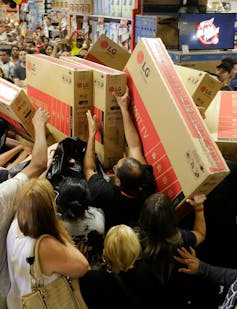Black Friday sales are on again. To score a genuine bargain, it helps to go in with a plan
- Written by Park Thaichon, Associate Professor of Marketing, University of Southern Queensland

Tomorrow is Black Friday, the official beginning of one of the biggest sales events of the year.
With so many consumers still feeling the cost-of-living pinch, it’s expected to once again bring bargain hunters out in droves.
While some sales have already started, market research company Roy Morgan estimates[1] Australian shoppers will spend a record $6.7 billion over the four-day shopping window. That’s up more than 5% on last year.
For Australians, it’s one of three big annual sales events. The others take place at the end of each financial year (EOFY)[2] and on Boxing Day[3].
Despite being a recent entrant to Australia, Black Friday has quickly become one of the most important shopping days of the year.
For consumers, navigating these sales and dodging the marketing tricks played by retailers is no mean feat. Here’s what you should know.
What exactly is Black Friday?
Black Friday as a major sales event originated in the United States. It falls on the day after Thanksgiving, which is celebrated on the fourth Thursday of November each year.
A four day sales window then typically runs over the weekend after Thanksgiving, including “Cyber Monday” – a similar event that was set up more recently to encourage online shopping.
But as you might have noticed, this official start date doesn’t prevent retailers from discounting products earlier, something many do.
Australians don’t officially celebrate Thanksgiving. Nonetheless, the sales event has gained significant traction here over the past decade or so.
This was initially driven by big US companies operating here, such as Apple and Amazon. But it was soon adopted and ultimately embraced by Australia’s own big retailers.
Some Australian retailers now say Black Friday has already overtaken Boxing Day[5] to become their most important sales event, a standing it could well cement further this year.
It’s been a similar story[6] across much of the world. Countries including Canada, Brazil, France and the UK all now mark the occasion with their own big sales events.
How do big sales work?
Black Friday and other big sales events are designed to create a sense of urgency. They lean heavily into the phenomenon known as fear of missing out[7] – called FOMO for short.
Retailers know that shoppers feel the pressure to buy when they think they might miss out. This is called scarcity marketing[8].
Retailers have ways of creating artificial scarcity, which can pressure us to make purchase decisions that aren’t in our best interests.
You’ve probably seen phrases in stores and online such as “only two left!” or “today only”. These tactics are designed to make you act.
The extent of savings can also depend on retailers’ dynamic pricing tactics. Many businesses use algorithms to adjust discounts in real time based on customer demand, inventory levels and competitor trends.
Popular items may start with small discounts, while less popular products get larger price cuts to attract interest.
How to be a savvy shopper
With these factors in mind, there are a few strategies that can help you you keep a clear head.
One tactic is to create a shopping list and understand the importance of sticking to predetermined purchase decisions and a predetermined budget. Prioritise needs over impulsive wants.
For example, if you need to replace an old keyboard amid a big sale, set a budget before you start looking, and try to avoid buying an entirely new computer just because it’s discounted in-store.
Shoppers should prepare for fluctuating prices, while being cautious of tactics such as artificially inflated “fake” discounts, where original prices are exaggerated to make savings seem more appealing.
Our previous research[10] has shown price promotion can trigger customer emotions such as surprise and lead to anticipated regret, influencing their purchase decisions.
Go in with a plan
Another tactic is to do some window shopping in the days or weeks beforehand. This allows you to check and research the products you’re interested in. Note down their non-sale prices for future reference.
Create a list of where to buy, along with a few alternatives. For shoes and clothing, try things on if you can and note down your size. That can help you act quickly once the sales go live.
And in the excitement of all the sales, don’t forget: if you don’t actually want or need anything, there’s always the option of not shopping at all.
References
- ^ estimates (www.roymorgan.com)
- ^ end of each financial year (EOFY) (theconversation.com)
- ^ Boxing Day (theconversation.com)
- ^ Nelson Antoine/Shutterstock (www.shutterstock.com)
- ^ overtaken Boxing Day (www.smh.com.au)
- ^ similar story (www.forbes.com)
- ^ fear of missing out (onlinelibrary.wiley.com)
- ^ scarcity marketing (www.emerald.com)
- ^ Diego Fedele/AAP (photos.aap.com.au)
- ^ research (www.emerald.com)
- ^ Kardasov Films/Shutterstock (www.shutterstock.com)
Authors: Park Thaichon, Associate Professor of Marketing, University of Southern Queensland













